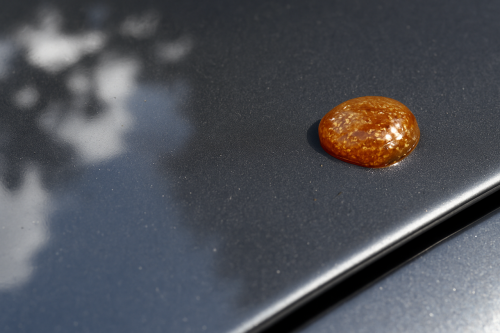Removing tree sap from a car’s paint, glass, or trim is a challenge every professional detailer and DIYer eventually faces. Whether it’s a sticky fresh drip or a hardened, sun-baked glob, the wrong approach can scratch paint or leave permanent etching.
This guide breaks down the best way to remove tree sap from your car without damaging your clear coat.

What Does Tree Sap Look Like on Cars?
Tree sap on a vehicle often appears as:
- Small, glossy amber or clear droplets on horizontal panels (hood, roof, trunk)
- Sticky spots that attract dust and grime
- Cloudy, crusty residue once hardened by sun exposure
On glass, it may look like water spots but feel tacky or raised when touched. Left untreated, sap can bond to clear coat, cause staining, and even lead to etching that requires correction.
Why Tree Sap Is Harmful to Car Paint
Tree sap contains sugars, resins, and acids that harden and bond with your car’s clear coat. When left untreated, it can:
- Eat through protective waxes or sealants
- Etch into clear coat under UV exposure
- Stain paint, requiring polishing or even repainting
- Damage rubber seals or plastics if spread
That’s why it’s critical to remove tree sap from your car as soon as possible, especially during the hot summer months.
Which Trees Produce the Most Sap?
Not that you have any control over what types of trees your customers park under, but detailers should know that the following types of trees produce sap:
- Maple trees are the largest group of sappy trees
- Walnut trees include butternut, black walnut, heartnut, and the English walnut
- Birch trees include paper birch, yellow birch, black birch, river birch, and gray birch
Best Way to Remove Tree Sap from a Car
If you’re wondering how to remove tree sap from a car without damaging paint, here’s the safest method used by pro detailers:
What You’ll Need:
- Ex-Con Concrete, Rust, and Tree Sap Remover
- Microfiber Towels
- Gloves (optional)
- Warm water (for rinse)
- pH-Balanced Car Wash Soap, like our Black Cherry Car Wash Soap
Detail King’s Ex-Con Concrete, Rust, and Tree Sap Remover is a specially formulated mix of mild, inorganic, non-fuming acid cleaning agents. Do not use Ex-Con in direct sunlight or on hot panels, and avoid applying it to unpainted plastic or rubber trim.
Step-by-Step: Tree Sap Removal Process
- Wash the vehicle first to remove loose debris and grime.
- Soak a microfiber towel with Ex-Con. Hold it over the sap spot for 30–60 seconds. This “softens” the sap without scrubbing.
- Gently wipe the area. Reapply if needed—some hardened sap requires 2–3 rounds.
- For stubborn spots, lightly press the towel against the sap and repeat until fully lifted.
- Rinse the area with clean water to neutralize any remaining residue.
Tip: Do not use Ex-Con on aluminum surfaces because irreversible damage may occur.
How to Get Tree Sap Off Car Windows
Window glass can also collect sap, especially under pine or maple trees.
For tree sap on car windows:
- Use the same Ex-Con method, making sure you don’t let the product dry.
- Avoid metal razor blades. Instead, use a plastic scraper or your fingernail with the soaked towel to lift residue.
- Finish with an ammonia-free glass cleaner, like our Ready To Use Glass Cleaner.
Common Mistakes to Avoid
While some DIY guides recommend rubbing alcohol or WD-40, these methods can:
- Dry out paint
- Leave residue
- Damage clear coat with repeated use
Our Ex-Con Concrete, Rust, and Tree Sap Remover is:
- VOC-compliant and safe on clear coat
- Designed for automotive use
- Strong enough for commercial detailers, safe for DIYers
It’s also effective on bird droppings, rust spots, and concrete splatter.
How to Protect Your Car After Tree Sap Removal
Once all of the tree sap is removed, apply a wax, sealant, or ceramic coating to protect the paint. Educate your customers on parking away from trees—or plan to detail the same area again soon.
FAQs
What removes tree sap from car paint best?
The safest and most effective remover is a professional-grade chemical like Ex-Con, formulated specifically for automotive use.
Can I use WD-40 to remove tree sap?
While it may loosen sap, it can leave an oily residue and is not paint-safe for repeated use. Use a dedicated tree sap remover instead.
How do I remove dried tree sap from a car without damaging paint?
Soften it with Ex-Con and a microfiber towel. Avoid scrubbing or scraping—let chemistry do the work.
Can tree sap permanently damage paint?
Yes. If left on too long, it can etch into the clear coat and require polishing or repainting.
Does tree sap come off with a car wash?
Not usually. Hardened sap needs chemical softening and targeted removal.
Whether you’re a mobile detailer handling customer vehicles or a DIYer keeping your ride spotless, using the right remover and technique ensures you won’t do more harm than good. For those offering detailing services, adding sap removal to your menu is a simple way to boost job value, customer satisfaction, and long-term results.

